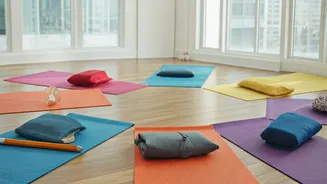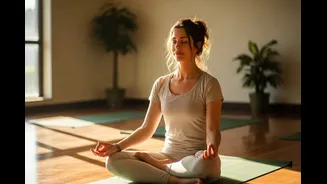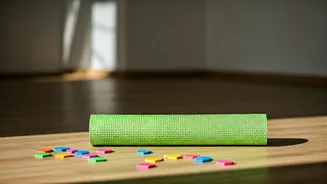Mind-Boosting Basics
Yoga, a practice originating in ancient India, has long been recognized for its physical and mental health benefits. Regularly performing yoga can significantly
impact cognitive function. These benefits include better memory, increased focus, and reduced stress levels. The beauty of yoga lies in its accessibility; anyone, regardless of age or physical condition, can start with a few basic poses. For this 10-minute routine, the emphasis is on a series of easily executed poses that are particularly effective at improving memory and focus. The key is to maintain consistent practice. Even dedicating just a few minutes each day can lead to substantial improvements in cognitive abilities. Through this guided practice, you'll learn how specific poses can unlock your mind's potential.
Tadasana (Mountain Pose)
Begin your yoga journey with Tadasana, or the Mountain Pose. It might seem simple, but this pose is fundamental for grounding and centering the mind. Stand with your feet firmly planted on the ground, toes pointed forward, and arms relaxed at your sides. Focus on your posture. Imagine a string gently pulling the crown of your head upward, lengthening your spine. Engage your core muscles lightly, and breathe deeply. This pose sets the foundation for your practice, helping to create a sense of presence and mental clarity. Tadasana is a grounding pose. It creates a feeling of stability and internal focus. Spend approximately one minute in the Mountain Pose to prepare your mind. Focus on your breath, and feel the connection to the earth below. This initial preparation is key for enhancing the effectiveness of the subsequent poses.
Uttanasana (Standing Forward Bend)
Next, move into Uttanasana, also known as the Standing Forward Bend. From Tadasana, slowly bend forward from your hips, allowing your head and arms to hang loosely toward the floor. If your hamstrings are tight, keep your knees slightly bent. The key is to release tension in the back and neck. This pose helps calm the brain and relieve stress. Deep breathing while in the forward bend can enhance the relaxation effect. Hold the pose for about a minute. Focus on lengthening your spine and releasing any tension in your shoulders. Uttanasana provides a soothing effect on the nervous system. This helps to reduce mental fatigue. It is a great way to transition into the more dynamic poses.
Adho Mukha Svanasana (Downward Dog)
Transition to Adho Mukha Svanasana, or Downward-Facing Dog. From Uttanasana, place your hands on the floor and step back, forming an inverted V-shape with your body. Spread your fingers wide and press firmly into your palms. Engage your core, and keep your back straight. This pose invigorates the body and improves blood flow to the brain, enhancing focus. Hold the pose for around a minute, focusing on lengthening your spine and creating space in your shoulders. Downward Dog is known for boosting energy and mental clarity. It is a powerful pose that promotes both physical and mental well-being. Regular practice can lead to increased alertness and improved memory.
Trikonasana (Triangle Pose)
Move into Trikonasana, or Triangle Pose. Stand with your feet wide apart, and turn your right foot out 90 degrees and your left foot slightly inward. Extend your arms out to the sides, and bend towards your right leg, reaching your right hand toward your shin or the floor. Keep your left arm extended upwards. Gaze up at your left hand if comfortable, and open your chest. This pose stimulates the brain and enhances concentration. Hold the pose for about 30 seconds on each side. Focus on your balance and deep breathing. Triangle Pose aids in improving spatial awareness and focus. This can greatly benefit cognitive performance. After 30 seconds on one side, switch to the other side.
Vrksasana (Tree Pose)
Now, perform Vrksasana, or Tree Pose. Stand tall with your feet together. Shift your weight onto your left leg and place the sole of your right foot on your inner left thigh, either at the ankle, calf, or inner thigh. Bring your hands to your chest in prayer position, and focus on a fixed point in front of you. This pose enhances balance and mental stability, promoting clarity. Hold the pose for about a minute, focusing on keeping your spine straight and your breath steady. Vrksasana fosters concentration and reduces mental clutter. This can bring a sense of calm and enhanced mental capabilities. After one minute, repeat the pose on the other side.
Savasana (Corpse Pose)
Conclude your practice with Savasana, or Corpse Pose. Lie flat on your back, with your arms at your sides and palms facing up. Close your eyes, and relax your entire body. Focus on your breath, and let go of any tension. This pose allows the brain to integrate the benefits of the other poses. It facilitates deep relaxation, reducing stress and enhancing memory consolidation. Stay in Savasana for at least 2 minutes. Allow your mind to become still and serene. Savasana is a crucial step. It is essential for maximizing the positive impacts of the yoga routine, leading to improved cognitive performance and a sense of calm.















